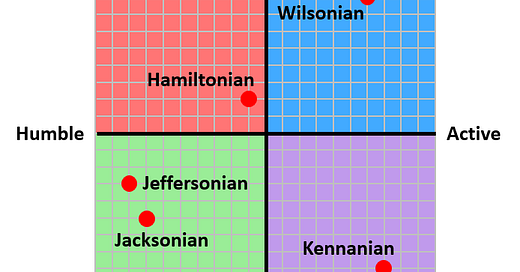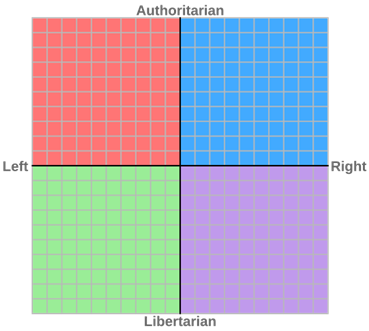The Foreign Policy Political Compass
A framework for understanding the current fight over US foreign policy
My last article outlined the four major types of US foreign policy, according to Walter Russell Mead. The four types, with oversimplified descriptions, are:
Hamiltonian – focused on commerce and international alliances
Jeffersonian – populist and isolationist, focused on maintaining democracy
Jacksonian – populist and isolationist, but will react forcefully when provoked
Wilsonian – idealist, focused on internationalism for the sake of human rights and morality
I ultimately argued that the Jeffersonian approach is better thought of as a precursor to the Jacksonian approach and that it doesn’t warrant its own category. Instead, I replaced the Jeffersonian tradition with the Kennanian approach, with another oversimplified explanation below:
Kennanian – realist, singularly focused on the zero-sum struggle against a rival hegemon
Many people are familiar with the original Political Compass, which maps out political ideologies along two axes, rather than just a simple left/right axis. The result is the graph below.
Using
’s framework for deciding which of Mead’s positions you agree with, we can map foreign policy positions on a similar 2x2 grid.From Kling’s article on Mead’s foreign policy typology:
Answer two questions. For each question, say which position you agree with more.
Do you prefer (idealism) America in its foreign policy should try to do the right thing morally; or (realism) The world is a tough place, and America cannot afford the luxury of trying for moral purity?
Do you prefer (activism) America has to actively engage in the world; or (humility) America should try to keep a low profile?
The four potential answers and the foreign policy type they match is below:
Idealism / activism – Wilsonian
Idealism / humility – Jeffersonian
Realism / activism – Hamiltonian
Realism / Humility – Jacksonian
The result is this foreign policy compass:
Using my revised framework and plotting each of the 5 positions individually, I’d argue the below is a more granular and more accurate view of where each of the foreign policy types fit.
Noticeably, the Jeffersonian and Jacksonian views are too close together to merit a meaningful distinction. Most of the idealism of the Jeffersonian approach is rooted in domestic ideals around democracy and agrarianism. Its isolationism is a realist approach to securing idealist domestic goals, which is why I put it on the realist end of the foreign policy spectrum.
The Hamiltonian approach, in my view, is also humbler and more idealist than Mead might argue, which is why I moved it from the bottom right quadrant to the middle / top left. The idealistic commitment to free trade and internationalism that characterized this view during the early 2000’s is a far cry from the much more restrictive and realist approach to trade supported by “America First” Jacksonians. Likewise, Hamiltonians are typically reluctant to intervene due to the disruptions large interventions pose for global commerce. Limited and narrowly focused interventions for economic ends merit a slightly humbler placement on the interventionist x-axis in my view.
Besides those two differences, we both agree that the Jacksonian view fits squarely in the bottom left quadrant and the Wilsonian view fits squarely in the top right quadrant. The Kennanian view I added also fits squarely in the bottom right quadrant.
So, which view will dominate the next decade?
The post-Cold War neoliberal consensus rested on the twin pillars of Hamiltonian and Wilsonian principles. The Kennanian approach of the Cold War was made obsolete with the fall of the Soviet Union in 1991. The successful and relatively costless NATO interventions in the former Yugoslavia in the 1990’s rendered the Jacksonian approach heartless and unreflective of America’s military capabilities. The downfall of the Kennanian and Jacksonian approaches during the 1990’s left the Hamiltonian and Wilsonian approaches as the most viable options for the 21st century.
The Hamiltonian approach went on to drive much of the focus on free trade and freedom of navigation that characterized the US’ early 21st century global naval hegemony. The Wilsonian approach and the desire for friendly liberal regimes and the protection of persecuted minorities likewise drove much of the US’ decision to invade Iraq in 2003. Throughout the late 1990’s and early 2000’s, the Hamiltonian and Wilsonian approaches reigned supreme.
This Wilsonian/Hamiltonian supremacy was short-lived, as the failure of the US to build a stable liberal state in Iraq has initiated a dramatic decline in Wilsonian sentiments over the past 15 years. The decline in Wilsonian thinking culminated in the US’ decision to not meaningfully intervene in the Syrian Civil War, despite the Assad regime’s clear use of chemical weapons against civilian populations.
A comparison of Bush’s decision to intervene in Iraq and Obama’s decision to not intervene in Syria is a great case study on the decline in Wilsonian thinking in the late 2000’s and early 2010’s. Over the same time period, the growing popular discontent with free trade and outsourced manufacturing has resulted in a decline in Hamiltonian thinking as well.
The teetering of both the Hamiltonian and Wilsonian approaches climaxed in 2016 with the election of Donald Trump, who represented a Jacksonian turn in US foreign policy. Donald Trump has been compared to Andrew Jackson many times, and Trump’s foreign policy is no exception.
Trump’s America First approach was groundbreaking in that it broke with two decades of Hamiltonian/Wilsonian foreign policy consensus. Despite its novelty compared to recent decades, Trump’s approach is part of a much longer trend of populist isolationism dating back to Jefferson and Jackson.
Had US enemies remained weak, Trump’s Jacksonian turn may have carried the day, but the continued rise and belligerence of China, coupled with the military aggression of both Russia and Iran, has made it clear to many that isolationism and a retreat from the world stage simply are not winning options. Amidst deepening ties between the autocratic regimes of China, Russia, Iran, and North Korea, a somewhat bipartisan consensus has emerged around the necessity of a return to a Kennanian approach that aims to contain and actively resist these regimes, especially China.
“Somewhat” in the previous sentence is doing a lot of work, as a second Trump presidency could see a return to a strongly Jacksonian outlook. As the Hamiltonian and Wilsonian approaches have continued to lose influence, the struggle over US foreign policy during this election cycle and for the coming decade will likely focus on the Jacksonian populism of Trump vs. the emerging Kennanism of the foreign policy establishment.
For Kennanism to be successful, it will need to win hearts and minds by appealing to its realism and distancing itself from the idealism of the early 21st century. This is no small task for Kennanists. Depending on the axis one looks at, Kennanism could be even more extreme than the Hamiltonian or Wilsonian approaches.
Looking at our foreign policy compass once again, the four types of foreign policy, in order from least interventionist to most (left to right), are:
Jacksonian – rarely intervenes unless provoked
Hamiltonian – limited interventions justified by economic considerations
Wilsonian – interventions justified by humanitarian reasons
Kennanian – interventions justified by hegemonic competition
By solely looking at relative appetite for interventions, the Kennanian approach seems doomed. Why would voters support a more interventionist approach to foreign policy, when it was the interventionism of the Hamiltonian and Wilsonian approaches that caused the Jacksonian turn in the first place? Under this framework, the Kennanian approach appears to be the most extreme.
However, in order from most idealist to most realist (top to bottom), the four types are:
Wilsonian – Highly idealist
Hamiltonian – Blend of realism and idealism, with its idealism showing up through ideological beliefs on trade and internationalism
Jacksonian – Highly realist with a high threshold for what constitutes an American interest abroad
Kennanian – Highly realist with the singular goal of outmaneuvering and defeating an adversary
On the realist/idealist spectrum, Kennanism is the opposite of the Wilsonian approach and is even more realist than the Jacksonian approach.
Trump’s resurgent Jacksonian foreign policy represents a reaction against the idealism and interventionism of the Hamiltonian and Wilsonian views. On the compass, this manifests as a mass movement downwards and to the left.
The question for Kennanists is, which driver is stronger? The public desire to move away from interventionism, or the public desire to move away from idealism? If the former, Kennanists may be the minority for the foreseeable future. If the latter, Kennanists have a good chance of controlling US foreign policy for the next decade.
For the Kennanists to be successful, they’ll need to coalesce around and fully articulate a vision of the new Kennanian approach to foreign policy and highlight its highly realist and self-interested qualities. The articulated differences between this approach and the Hamiltonian/Wilsonian approaches of the early 2000’s will be key to determining whether the new Kennanism will be electorally successful. If Jacksonians are able to paint Kennanism as an extension of the Wilsonian adventurism of the 2000’s, the Kennanists won’t stand a chance. Time will tell which approach will win out, but for the Kennanists to have a shot, they’ll need to focus on framing their proposals in realist, not idealist, terms.
TL;DR
The battle for the US’ foreign policy direction over the next decade will be fought between Jacksonians and Kennanists.
While both views represent a turn towards foreign policy realism (both are on the bottom half of the compass), the two views differ greatly in their approach to interventionism (nearly opposite ends of the x-axis).
The Jacksonian approach has a slight first mover advantage in that it gained popularity in the mid-2010’s under Trump. For the Kennanian approach to be successful in superseding the Jacksonian approach over the coming decade, Kennanists will need to frame their approach as highly realist and self-interested, as opposed to the Wilsonian idealism of the 2000’s.








Interesting article. I think what you call Kennanism has had limited impact on American foreign policy thinking. It harkens back to a European-style realism that is best represented by Metternich in the early 19th century. It’s only real practitioners in American history were Kissinger and Nixon. As you point out, the Cold War coalition is best seen as an alliance of Wilsonians and Hamiltonians.
American foreign wars acquire widespread popular support when it combines national interests (realism) and national values (idealism). We can see this in the American Revolution, Civil war, WWI, WWII and the Cold War. Idealism alone is not enough when victory is not immediate and decisive. Realism on the other hand is not enough to get popular support unless the nation is attacked like Pearl Harbor.
For these reasons, a value-free realism will likely never be popular in the US. But since our rivals are almost always aggressive, undemocratic regimes, then it is not too hard to see both interests and values at stake. Both Communist China and Putin’s Russia fit the mold of adversaries of the past.